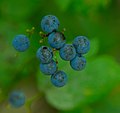|
Caulophyllum thalictroides
Caulophyllum thalictroides, the blue cohosh, is a species of flowering plant in the Berberidaceae (barberry) family. It is a medium-tall perennial with blue berry-like fruits and bluish-green foliage. The common name cohosh is probably from an Algonquian word meaning "rough".[citation needed] The Greek-derived genus name Caulophyllum signifies "stem-leaf", while the specific name thalictroides references the similarity between the large highly divided, multiple-compound leaves of meadow-rues (Thalictrum spp.) and those of blue cohosh. DescriptionFrom the single stalk rising from the ground, there springs a single, large, three-branched leaf, giving rise to a yellow-flowered inflorescence, followed by bluish berries, coated with a glaucous, waxy bloom, somewhat similar in appearance to sloes. The bluish-green leaflets are three-lobed and entire at the base, but serrate at the tip. Habitat and DistributionThe plant is found in hardwood forests and favors moist coves and hillsides, generally in shady locations, in rich soil. It grows in eastern North America, from Manitoba and Oklahoma east to the Atlantic Ocean. PollinationThe plant is pollinated early in the season by certain bee species, which are attracted by the nectar glands present on the petals.[1] UsesThe plant has been used as a medicinal herb by American Indians.[2] Many Native American tribes, and later European herbologists and mid-wives,[3] would use this herb in conjunction with other herbs and fluids for abortive and contraceptive purposes.[4] The seeds have also reportedly been used a coffee substitute.[1] Gallery
Chemical CompositionThe root contains essential fatty acids, glucosides, phytosterols, saponins, and resinous essential oil.[5] See also
References
External links
Wikimedia Commons has media related to Caulophyllum thalictroides. |
||||||||||||||||||||||||||













